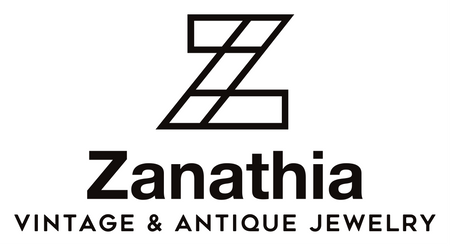
The Exposition International des Arts Decoratifs et Industriels Modernes Official poster, designed by French Illustrator Robert Bonfils (1886-1972). Courtesy of the Victoria and Albert Museum Collection
The Art Deco Era represented a heightened excitement and avid interest in modern technology and glamour. The period is known for its unique architectural designs created with fine craftsmanship and luxury. After the end of World War I, many social changes occurred. Womenswear became less restrictive, and new fashions eloped. Long sautoir necklaces were casually worn by ladies, including strands of pearls and cut glass beads. Innovations and ideas were welcomed, with Europe in a celebratory spirit after the War. Naturally, societal factors molded a new aesthetic for the period, and Art Deco Era jewelry officially became in vogue.

Art Deco Era jewelry designs were inspired by various styles, which include ancient Egyptian motifs and oriental designs. Archaeological excavations in Egypt heavily influenced jewelry designs, which included scarabs and pyramids. Advanced Lacquer techniques were developed in the Far East, emphasizing sophisticated, polished jewelry designs. Historical pre-Colombian artwork, Cubism, and the use of geometric designs were primary inspirations as well. Art was highly stressed and promoted during the era. Artisans of various design backgrounds came together and worked as a collective to create unique jewelry. Formally called bijoutiers-artistes, these influential artists emphasized the intricate design of jewelry. The Parisian bijoutiers-joailliers, another significant influence during the Art Deco Era, focused on creating geometric designs with colored gemstones with a focus on a center stone setting.

Art Deco Era Byjoux Jewelry illustration, 1927. Featuring artistic geometric designs. Archives collection.

Art Deco Era jewelry Ad from ST&W Company, 1930. The catalog features various geometric necklaces and pendants with ‘a sterling touch’.
Art Deco Era designs are distinct and include caliber cut stones, geometric shapes, and intricately cut filigree work. Popular materials used in jewelry designs were platinum, Marcasites, glass, pearls, and rubies. Art Deco Era jewelry was lighter than previous styles from the Victorian and Art Nouveau eras. Prolific designers during the time included CoCo Chanel (1883-1971) and the Van Cleef and Arpels company, credited for developing the “invisible setting” on rings.

Coco Chanel, the French fashion designer, is credited with popularizing the less restrictive and casual chic womenswear look post World War I. Photo courtesy of Roger Viollet/Getty Images
There were numerous technological advances in jewelry making during the early 20th century. The innovations can be seen in the designs and materials of choice during the Art Deco Era. High-quality synthetic gemstones and materials were increasingly used for imitating natural stones. Bakelite, synthetic rubies, and sapphires were used for rectangular rings and other geometric designs. White gold and cultured pearls were trendy during the 1920s, becoming an iconic signature look of the Art Deco Era.

1927 Woolworth Co. Jewelry ad featuring necklaces with high-quality synthetic gemstones.

1922 Art Deco Era Brooch and Necklace Ellis Gift Catalog From The Ellis Brothers Ltd Catalog, Toronto, Canada. Archives.org
After Bohemia was dissolved and became Czechoslovakia in 1918, distinctive, high-quality glass and crystal jewelry began to be exported until World War II. Art Deco Era Czech jewelry included beaded tassel necklaces and intricately cut brooches with filigree work. Czech jewelry became so popular that other regions began to imitate its aesthetic and quality.

Art Deco Era Amber Czech beaded tassel necklace. Zanathia Jewelry Collection

Art Deco Era Czech Amber Glass, Seed Pearl, and brass filigree necklace. Zanathia Jewelry Collection
Art Deco Era jewelry has established its mark and legacy and inspired countless modern designs. The Art Deco design can be seen in delicate jewelry styles, including rings and earrings. The period was inspired by modernism, societal changes after World War I, archaeological discoveries, artwork, cultural influences, and the welcoming of new designs in the age of technology. The Art Deco aesthetic is still emphasized and a significant inspiration within the design industries.

